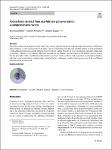Item Infomation
Full metadata record
| DC Field | Value | Language |
|---|---|---|
| dc.contributor.author | Karin, Ratzenböck | - |
| dc.contributor.author | Susanne M., Fischer | - |
| dc.contributor.author | Christian, Slugovc | - |
| dc.date.accessioned | 2023-04-20T07:35:23Z | - |
| dc.date.available | 2023-04-20T07:35:23Z | - |
| dc.date.issued | 2023 | - |
| dc.identifier.uri | https://link.springer.com/article/10.1007/s00706-023-03049-4 | - |
| dc.identifier.uri | https://dlib.phenikaa-uni.edu.vn/handle/PNK/8153 | - |
| dc.description | CC BY | vi |
| dc.description.abstract | Poly(ether)s represent an important class of polymers and are typically formed by ring-opening polymerization, Williamson ether synthesis, or self-condensation of alcohols. The oxa-Michael reaction presents another method to form poly(ether)s with additional functional groups in the polymer backbone starting from di- or triols and electron deficient olefins such as acrylates, sulfones, or acrylamides. However, research on oxa-Michael polymerization is still limited. Herein, we outline the principles of the oxa-Michael polymerization and focus on the synthesis and preparation of poly(ether-sulfone)s, poly(ether-ester)s, poly(ether)s, and poly(ether-amide)s. Further, challenges as well as future perspectives of the oxa-Michael polymerization are discussed. | vi |
| dc.language.iso | en | vi |
| dc.publisher | Springer | vi |
| dc.subject | oxa-Michael reaction | vi |
| dc.subject | oxa-Michael polymerization | vi |
| dc.title | Poly(ether)s derived from oxa-Michael polymerization: a comprehensive review | vi |
| dc.type | Book | vi |
| Appears in Collections | ||
| OER - Khoa học Tự nhiên | ||
Files in This Item:

